ASRock Z87E-ITX Review: Motherboard Juxtaposition
by Ian Cutress on November 6, 2013 10:00 AM EST- Posted in
- Motherboards
- ASRock
- Mini ITX
- Haswell
- Z87
Computational Benchmarks
Readers of our motherboard review section will have noted the trend in modern motherboards to implement a form of MultiCore Enhancement / Acceleration / Turbo (read our report here) on their motherboards. This does several things – better benchmark results at stock settings (not entirely needed if overclocking is an end-user goal), at the expense of heat and temperature, but also gives in essence an automatic overclock which may be against what the user wants. Our testing methodology is ‘out-of-the-box’, with the latest public BIOS installed and XMP enabled, and thus subject to the whims of this feature. It is ultimately up to the motherboard manufacturer to take this risk – and manufacturers taking risks in the setup is something they do on every product (think C-state settings, USB priority, DPC Latency / monitoring priority, memory subtimings at JEDEC). Processor speed change is part of that risk which is clearly visible, and ultimately if no overclocking is planned, some motherboards will affect how fast that shiny new processor goes and can be an important factor in the purchase.
For reference, on BIOS 2.10 as tested, the Z87E-ITX does NOT implement MultiCore Turbo by default, and thus follows Intel specifications.
Point Calculations - 3D Movement Algorithm Test
The algorithms in 3DPM employ both uniform random number generation or normal distribution random number generation, and vary in various amounts of trigonometric operations, conditional statements, generation and rejection, fused operations, etc. The benchmark runs through six algorithms for a specified number of particles and steps, and calculates the speed of each algorithm, then sums them all for a final score. This is an example of a real world situation that a computational scientist may find themselves in, rather than a pure synthetic benchmark. The benchmark is also parallel between particles simulated, and we test the single thread performance as well as the multi-threaded performance.
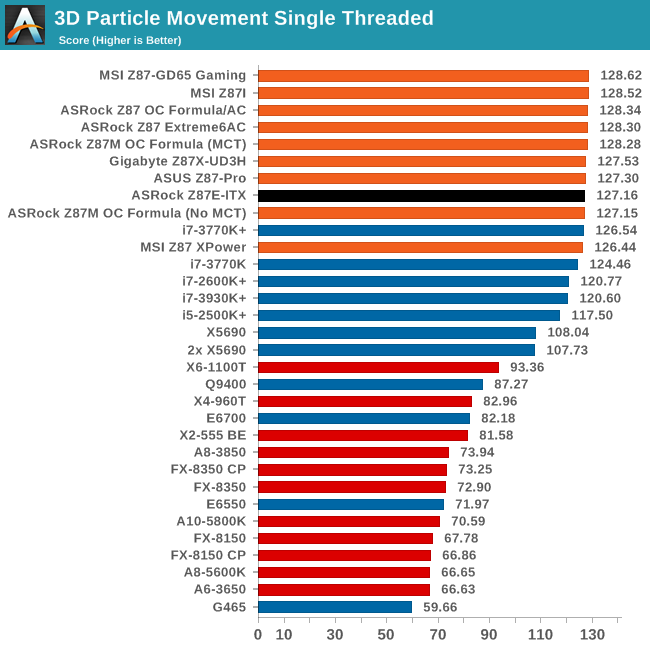
In single core performance, where MCT does not matter, the Z87E-ITX does not set any records alight, even performing near the rear end of our Z87 testing in line with the Z87 OC Formula with a No MCT BIOS.
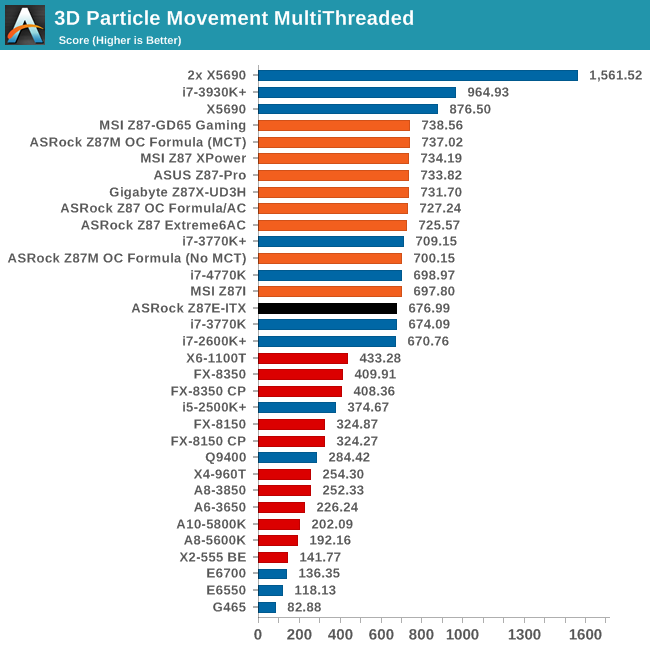
The lack of MCT should affect the multi-threaded test more, but the Z87E-ITX actually performs worse than expected, somewhere near a 3770K with MCT.
Compression - WinRAR 4.2
With 64-bit WinRAR, we compress the set of files used in the USB speed tests. WinRAR x64 3.93 attempts to use multithreading when possible, and provides as a good test for when a system has variable threaded load. WinRAR 4.2 does this a lot better! If a system has multiple speeds to invoke at different loading, the switching between those speeds will determine how well the system will do.
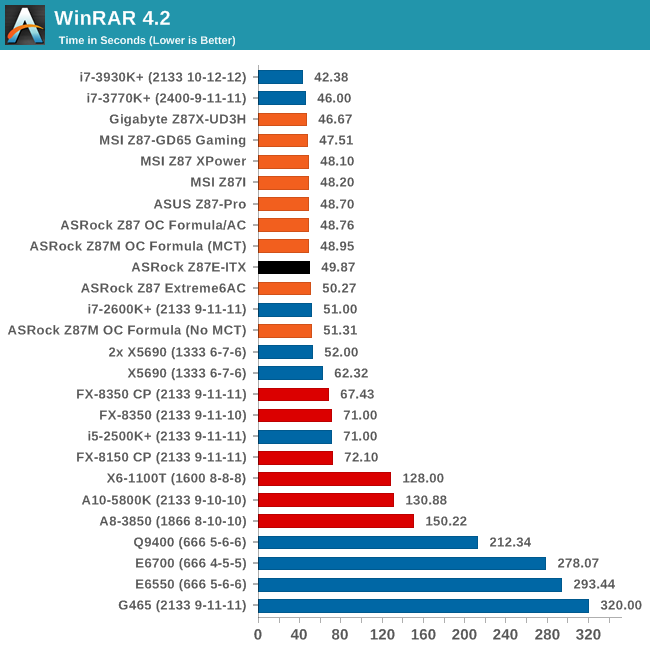
Surprisingly the Z87E-ITX performs better than the Z87 Extreme6/AC, which did have MCT enabled. It would seem that ASRock have optimized some of their turbo boosting routines from launch.
Image Manipulation - FastStone Image Viewer 4.2
FastStone Image Viewer is a free piece of software I have been using for quite a few years now. It allows quick viewing of flat images, as well as resizing, changing color depth, adding simple text or simple filters. It also has a bulk image conversion tool, which we use here. The software currently operates only in single-thread mode, which should change in later versions of the software. For this test, we convert a series of 170 files, of various resolutions, dimensions and types (of a total size of 163MB), all to the .gif format of 640x480 dimensions.

No surprises here – all motherboards taking 48-49 seconds in FastStone.
Video Conversion - Xilisoft Video Converter 7
With XVC, users can convert any type of normal video to any compatible format for smartphones, tablets and other devices. By default, it uses all available threads on the system, and in the presence of appropriate graphics cards, can utilize CUDA for NVIDIA GPUs as well as AMD WinAPP for AMD GPUs. For this test, we use a set of 33 HD videos, each lasting 30 seconds, and convert them from 1080p to an iPod H.264 video format using just the CPU. The time taken to convert these videos gives us our result.
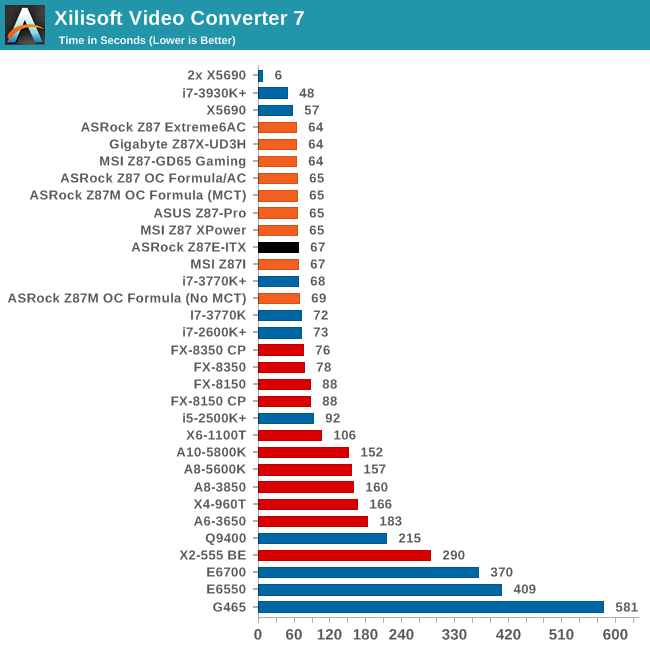
In the XVC test, the Z87E-ITX beats the OC Formula without MCT, and is actually on par with the MSI Z87I which did have MCT enabled.
Rendering – PovRay 3.7
The Persistence of Vision RayTracer, or PovRay, is a freeware package for as the name suggests, ray tracing. It is a pure renderer, rather than modeling software, but the latest beta version contains a handy benchmark for stressing all processing threads on a platform. We have been using this test in motherboard reviews to test memory stability at various CPU speeds to good effect – if it passes the test, the IMC in the CPU is stable for a given CPU speed. As a CPU test, it runs for approximately 2-3 minutes on high end platforms.
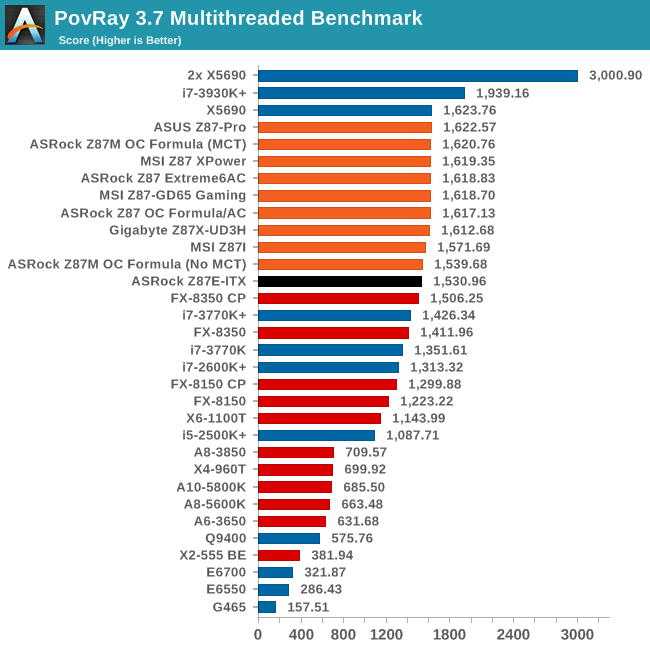
The Z87E-ITX joins the No MCT results from the OC Formula at the bottom of the Z87 testing for PovRay.
Video Conversion - x264 HD Benchmark
The x264 HD Benchmark uses a common HD encoding tool to process an HD MPEG2 source at 1280x720 at 3963 Kbps. This test represents a standardized result which can be compared across other reviews, and is dependent on both CPU power and memory speed. The benchmark performs a 2-pass encode, and the results shown are the average of each pass performed four times.
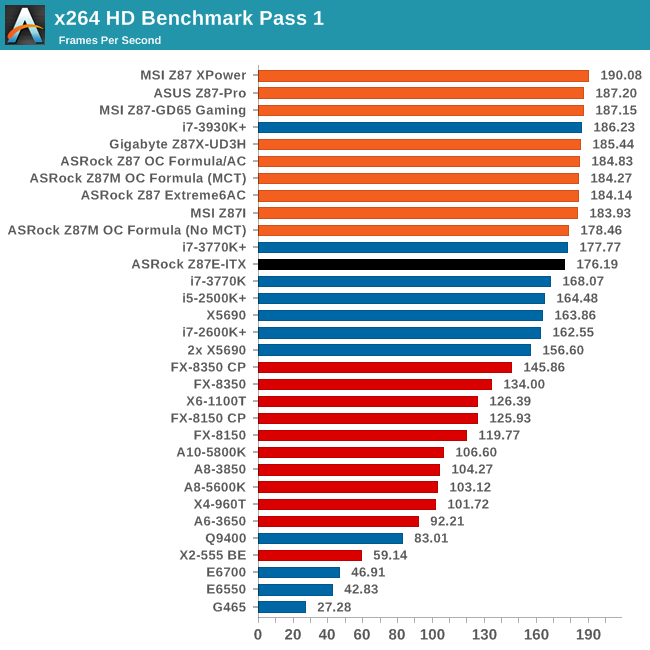
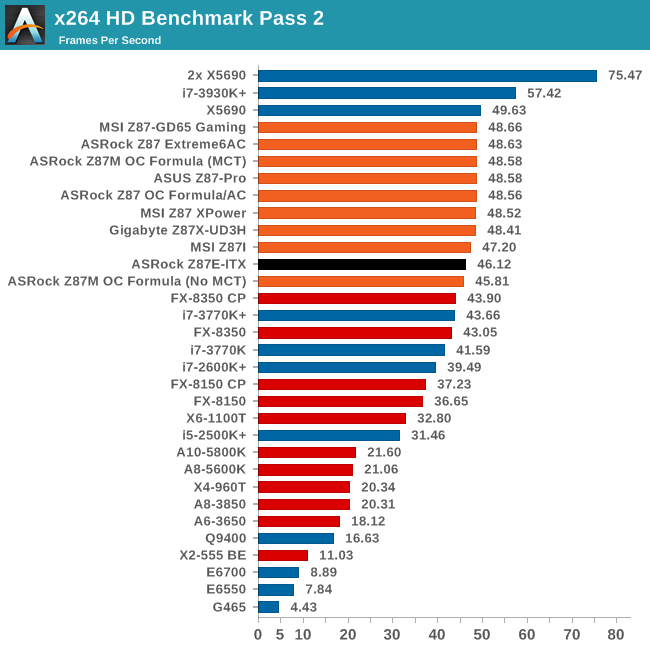
Grid Solvers - Explicit Finite Difference
For any grid of regular nodes, the simplest way to calculate the next time step is to use the values of those around it. This makes for easy mathematics and parallel simulation, as each node calculated is only dependent on the previous time step, not the nodes around it on the current calculated time step. By choosing a regular grid, we reduce the levels of memory access required for irregular grids. We test both 2D and 3D explicit finite difference simulations with 2n nodes in each dimension, using OpenMP as the threading operator in single precision. The grid is isotropic and the boundary conditions are sinks. Values are floating point, with memory cache sizes and speeds playing a part in the overall score.
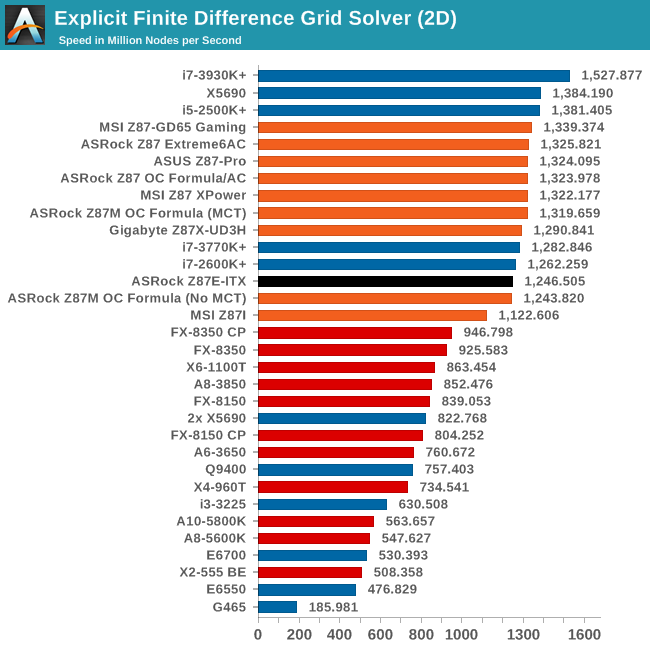
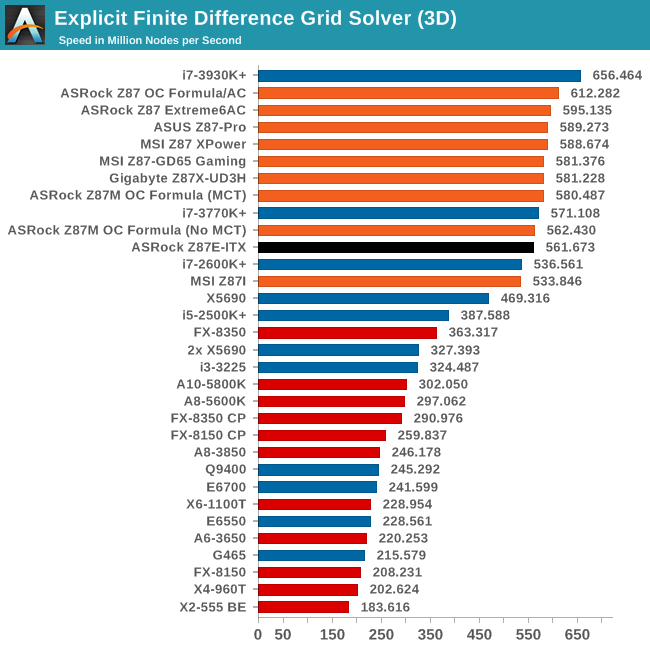
Explicit Finite Difference loves a bit of IPC, but due to the lack of MCT out of the box, the Z87E-ITX joins the other non-MCT results.
Grid Solvers - Implicit Finite Difference + Alternating Direction Implicit Method
The implicit method takes a different approach to the explicit method – instead of considering one unknown in the new time step to be calculated from known elements in the previous time step, we consider that an old point can influence several new points by way of simultaneous equations. This adds to the complexity of the simulation – the grid of nodes is solved as a series of rows and columns rather than points, reducing the parallel nature of the simulation by a dimension and drastically increasing the memory requirements of each thread. The upside, as noted above, is the less stringent stability rules related to time steps and grid spacing. For this we simulate a 2D grid of 2n nodes in each dimension, using OpenMP in single precision. Again our grid is isotropic with the boundaries acting as sinks. Values are floating point, with memory cache sizes and speeds playing a part in the overall score.
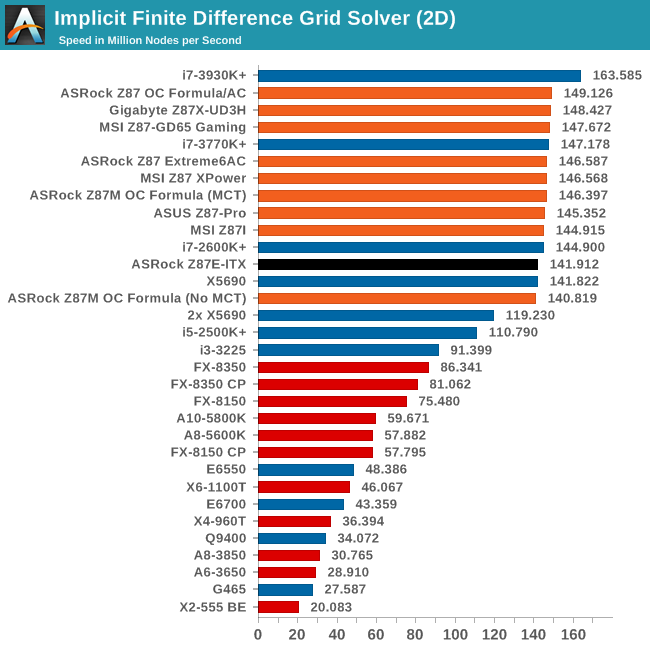
Point Calculations - n-Body Simulation
When a series of heavy mass elements are in space, they interact with each other through the force of gravity. Thus when a star cluster forms, the interaction of every large mass with every other large mass defines the speed at which these elements approach each other. When dealing with millions and billions of stars on such a large scale, the movement of each of these stars can be simulated through the physical theorems that describe the interactions. The benchmark detects whether the processor is SSE2 or SSE4 capable, and implements the relative code. We run a simulation of 10240 particles of equal mass - the output for this code is in terms of GFLOPs, and the result recorded was the peak GFLOPs value.
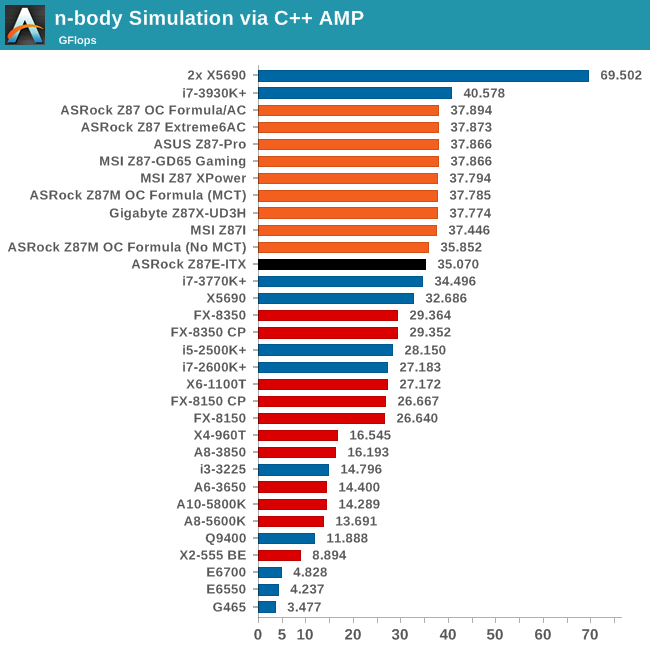










43 Comments
View All Comments
IanCutress - Wednesday, November 6, 2013 - link
I've already covered the Z87M OC Formula, and I have the Gryphon in for review, as well as a gaming mATX. I hope to get to them by the end of the year :) You have two options for WiFi: USB device, or PCIe x1 card.althaz - Wednesday, November 6, 2013 - link
Also, I can assure you that the 290 is not quiet enough. It almost doens't matter what for, if you have to ask about the noise, it'll probably bother you, IMO.Aikouka - Wednesday, November 6, 2013 - link
I've been looking at this board for a while, so it was a nice treat to see the review pop up this morning. The main use that I have for this board is for HTPCs. I like using the Streacom cases (Ganesh reviewed one for Anandtech), and the cases require very little obstruction from the top of the motherboard to the CPU. Unfortunately, a lot of Mini-ITX boards put the memory or 24-pin power connector up there. Also, most boards don't have mSATA ports on them, which is nice because forgoing a 2.5" drive helps to reduce the cable clutter in a really small case.All that said, it's good to see that the board received some praise! I just need to wait for Perfect Home Theater to get the short Streacom heat pipes in stock first since the CPU socket is a lot closer to the top than on most motherboards.
vykos - Wednesday, November 6, 2013 - link
Actually, the cheapest board with 802.11ac is Gigabyte's FM2+ mITX board for $110 on Newegg: GA-F2A88XN-WIFIhttp://www.newegg.com/Product/Product.aspx?Item=N8...
IanCutress - Wednesday, November 6, 2013 - link
I just got wind of this via email. It seems fairly new - it doesn't show up on various searches either. So that makes it Gigabyte cheapest on AMD, ASRock on Intel. This means good things: 802.11ac should be ubiquitous up and down the product stack and single band 2.4 GHz should not see the light of day.Ian
popej - Wednesday, November 6, 2013 - link
Quote from review: "the dynamic range is low for an ALC1150".For typical codec a loop-back test actually measures line-in performance, since AD converters are usually worst then DAC. And results are in perfect accord with ALC1150 data sheet, which states typical ADC dynamic range -104dB and THD+N -80dB.
Line-in performance is maybe not the most interesting parameters for a motherboard, but at least measurement have proved, that codec implementation is correct.
lekzero - Wednesday, November 6, 2013 - link
I believe this mb is used in "Steam Box prototype", I believe I also saw a power supply Silverstone's ST45SF-G also in SBox.Hrel - Wednesday, November 6, 2013 - link
I just built a new computer using this board, in a Fractal Design Node 304 case. Core i5 4570S, 8GB of DDR3 1866 and my old GTX460 768MB GPU. Pretty happy with it. Put some velcro stickies on a slim external DVD burner and put it on top of the case, looks good, is quiet, and is fully functional. Pretty happy I can finally build a small form factor computer without having to give up anything.The newegg video on the case says long graphics cards could conflict with modular PSU's. This wasn't the case for the Seasonic G...something. 550W hybrid fan PSU I put in it. Just fyi. The modular ports sit below the GPU, so it is tight, but a GTX780 should fit in there just fine.
BernardP - Wednesday, November 6, 2013 - link
Could someone explain what are the uses for the onboard WiFi? This has been puzzling me for some time.I already have a wireless router at home. What could this onboard WiFi add?
DanNeely - Wednesday, November 6, 2013 - link
The same thing as the wifi on your laptop, tablet, and phone; it lets you connect to the router without running an ethernet cable.